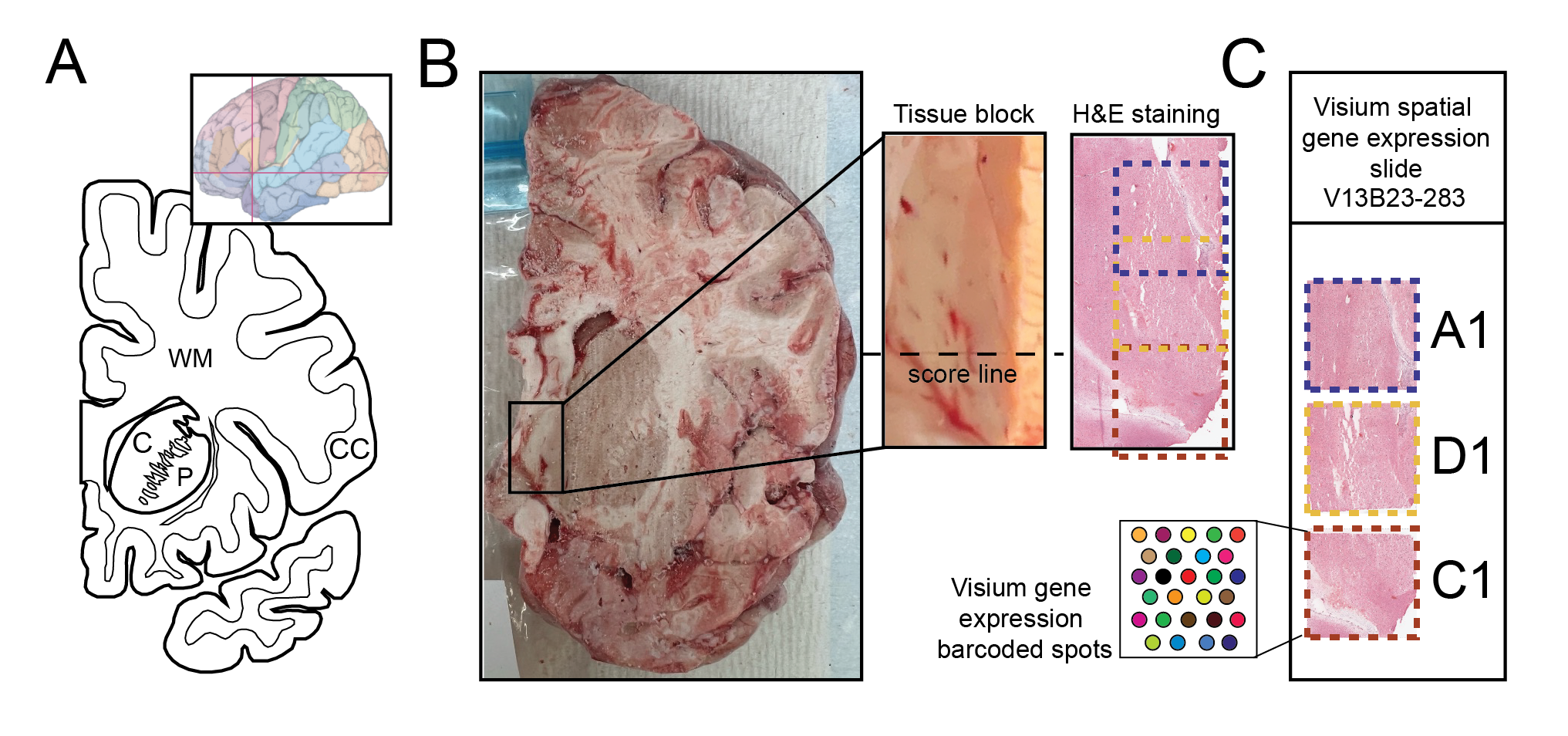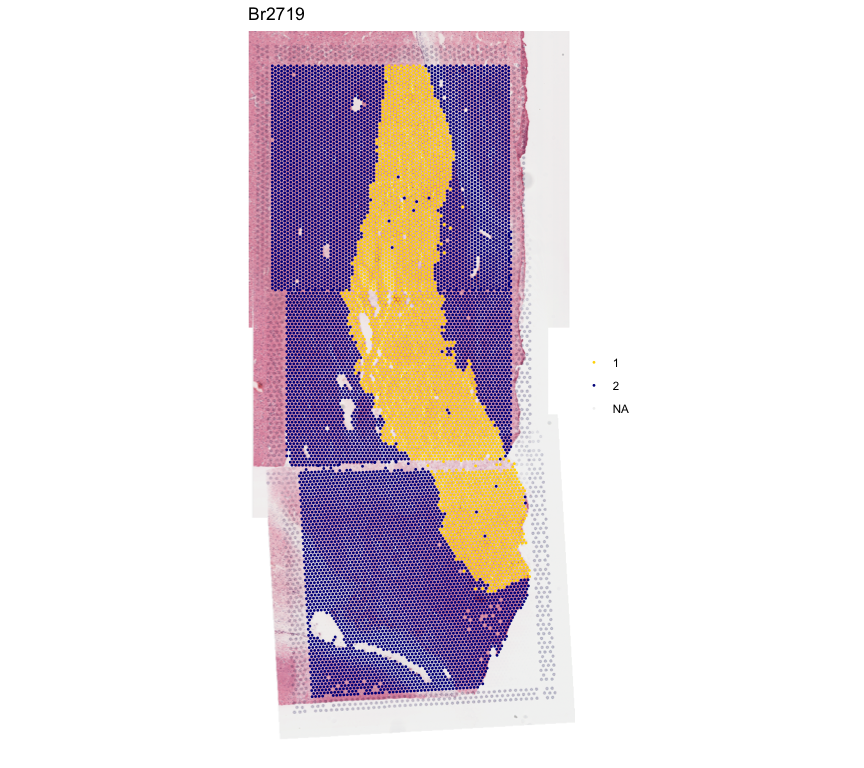This repository contains the data used to demonstrate the utility of
visiumStitched.
Three
Visium
capture areas were collected from the postmortem human brain from one
donor. We used Fiji and
visiumStitched to stitch the gene-expression and imaging data into one
sample for downstream analysis.
If you tweet about this website, the data or the R package please use
the #visiumStitched hashtag. You can find previous tweets
that way as shown
here.
Thank you for your interest in our work!
Figure 1. Experimental design to generate spatially-resolved transcriptomics (SRT) data from postmortem human brain across three Visium capture areas.
(A) Schematics illustrating a coronal human brain hemisphere at the level of the anterior striatum. Inset showing an illustration of the lateral side of the brain with a vertical red line depicting the location of the coronal slab. CC – cerebral cortex, C – caudate nucleus, P – putamen, WM – white matter. (B) Raw coronal brain slab, dissected tissue block with an indicated score line, and H&E staining of the 10 µm section taken from the same block. (C) A diagram depicting how tissue sections were arranged on the Visium slide with capture arrays A1 (blue) and D1 (yellow) arranged partially overlapping, while capture arrays D1 (yellow) and C1 (red) arranged adjacent to each other across a score line.
Here is a short overview video of the stitching steps performed with
Fiji.
Check out this
guide
describing how to use visiumStitched with the outputs of Fiji, which
enabled the integration of all three capture areas for this project.
This resulted in a
SpatialExperiment
object that can be used seamlessly for downstream analyses steps, such
as performing spatially-aware clustering with tools such as
BayesSpace and
PRECAST.
Explore the stitched example data using the interactive website, powered by spatialLIBD.
Alternatively, you may choose to run the interactive website locally
with
spatialLIBD::run_app(),
which gives more freedom regarding memory usage and session length. See
this
example
for invoking spatialLIBD::run_app() with an appropriate set of
arguments.
For this human brain dataset composed of 3 Visium capture areas, the
transcriptomics data,
SpaceRanger
outputs, and Fiji outputs are all
available through spatialLIBD::fetch_data() (version 1.17.8 or newer).
A comprehensive vignette using these objects is written
here.
## Check that you have a recent version of spatialLIBD installed
stopifnot(packageVersion("spatialLIBD") >= "1.17.8")
## Download the spot-level data, which is a SpatialExperiment object
spe <- spatialLIBD::fetch_data(type = "visiumStitched_brain_spe")
#> 2024-07-31 12:06:23.311805 loading file /Users/leocollado/Library/Caches/org.R-project.R/R/BiocFileCache/154352e7328f0_visiumStitched_brain_spe.rds%3Frlkey%3Dnq6a82u23xuu9hohr86oodwdi%26dl%3D1
spe
#> class: SpatialExperiment
#> dim: 26369 13965
#> metadata(0):
#> assays(2): counts logcounts
#> rownames(26369): ENSG00000238009 ENSG00000241860 ... ENSG00000278817
#> ENSG00000277196
#> rowData names(7): source type ... gene_type gene_search
#> colnames(13965): AAACAACGAATAGTTC-1_V13B23-283_A1
#> AAACAAGTATCTCCCA-1_V13B23-283_A1 ... TTGTTTGTATTACACG-1_V13B23-283_D1
#> TTGTTTGTGTAAATTC-1_V13B23-283_D1
#> colData names(40): sample_id in_tissue ... precast_k4 precast_k8
#> reducedDimNames(1): PCA
#> mainExpName: NULL
#> altExpNames(0):
#> spatialCoords names(2) : pxl_col_in_fullres pxl_row_in_fullres
#> imgData names(4): sample_id image_id data scaleFactor
## Show clustering results from PRECAST at k = 2
spatialLIBD::vis_clus(
spe,
clustervar = 'precast_k2',
is_stitched = TRUE,
colors = c(
"1" = "gold",
"2" = "darkblue",
"NA" = "white"
)
)The source data described in this manuscript are available from
Globus
(jhpce#visiumStitched_brain). This includes all the input FASTQ files
as well as the outputs from
SpaceRanger.
Below is the citation output from using citation('visiumStitched') in
R. Please run this yourself to check for any updates on how to cite
visiumStitched.
print(citation("visiumStitched")[2], bibtex = TRUE)
#> Eagles NJ, Bach S, Tippani M, Ravichandran P, Du Y, Miller RA, Hyde TM,
#> Page SC, Martinowich K, Collado-Torres L (2024). "visiumStitched."
#> _bioRxiv_. doi:10.1101/TODO <https://doi.org/10.1101/TODO>,
#> <https://www.biorxiv.org/content/10.1101/TODO>.
#>
#> A BibTeX entry for LaTeX users is
#>
#> @Article{,
#> title = {visiumStitched},
#> author = {Nicholas J. Eagles and Svitlana Bach and Madhavi Tippani and Prashanthi Ravichandran and Yufeng Du and Ryan A. Miller and Thomas M. Hyde and Stephanie C. Page and Keri Martinowich and Leonardo Collado-Torres},
#> year = {2024},
#> journal = {bioRxiv},
#> doi = {10.1101/TODO},
#> url = {https://www.biorxiv.org/content/10.1101/TODO},
#> }Please note that visiumStiched was only made possible thanks to many
other R and bioinformatics software authors, which are cited either in
the vignettes and/or the paper(s) describing the package.
Below is the citation output from using citation('spatialLIBD') in R.
Please run this yourself to check for any updates on how to cite
spatialLIBD.
print(citation("spatialLIBD")[1], bibtex = TRUE)
#> Pardo B, Spangler A, Weber LM, Hicks SC, Jaffe AE, Martinowich K,
#> Maynard KR, Collado-Torres L (2022). "spatialLIBD: an R/Bioconductor
#> package to visualize spatially-resolved transcriptomics data." _BMC
#> Genomics_. doi:10.1186/s12864-022-08601-w
#> <https://doi.org/10.1186/s12864-022-08601-w>,
#> <https://doi.org/10.1186/s12864-022-08601-w>.
#>
#> A BibTeX entry for LaTeX users is
#>
#> @Article{,
#> title = {spatialLIBD: an R/Bioconductor package to visualize spatially-resolved transcriptomics data},
#> author = {Brenda Pardo and Abby Spangler and Lukas M. Weber and Stephanie C. Hicks and Andrew E. Jaffe and Keri Martinowich and Kristen R. Maynard and Leonardo Collado-Torres},
#> year = {2022},
#> journal = {BMC Genomics},
#> doi = {10.1186/s12864-022-08601-w},
#> url = {https://doi.org/10.1186/s12864-022-08601-w},
#> }- JHPCE location:
/dcs05/lieber/lcolladotor/visiumStitched_LIBD1070/visiumStitched_brain.
The code in this repository follows the organization from https://github.com/LieberInstitute/template_project following the guidelines from organizing-your-work.

